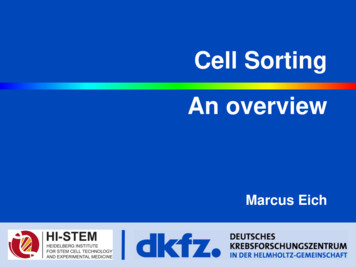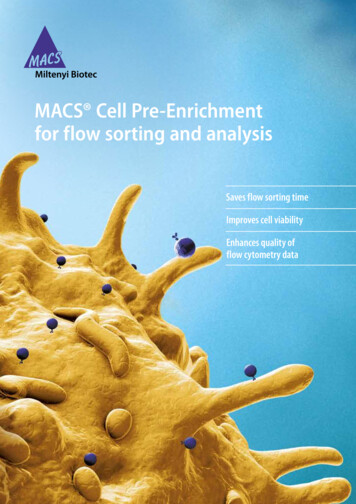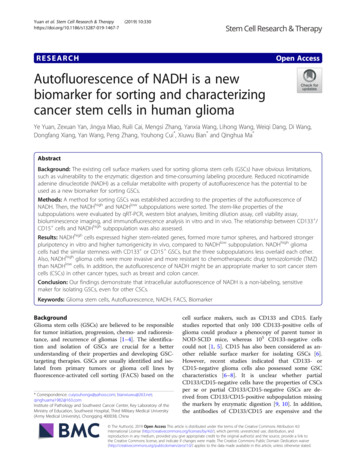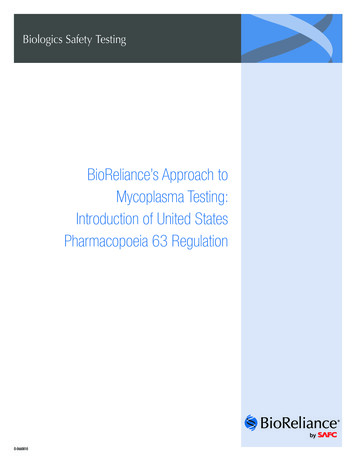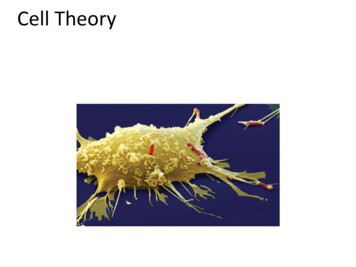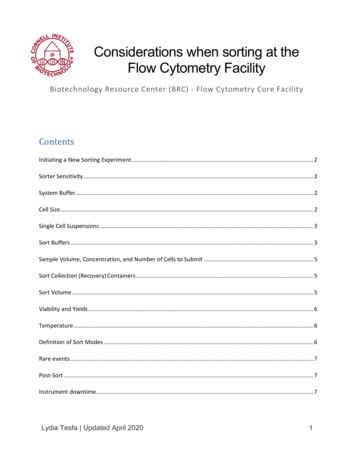
Transcription
Considerations when sorting at theFlow Cytometry FacilityBiotechnology Resource Center (BRC) - Flow Cytometry Core FacilityContentsInitiating a New Sorting Experiment . 2Sorter Sensitivity . 2System Buffer. 2Cell Size . 2Single Cell Suspensions . 3Sort Buffers . 3Sample Volume, Concentration, and Number of Cells to Submit . 5Sort Collection (Recovery) Containers . 5Sort Volume . 5Viability and Yields . 6Temperature . 6Definition of Sort Modes . 6Rare events . 7Post-Sort . 7Instrument downtime . 7Lydia Tesfa Updated April 20201
Initiating a New Sorting ExperimentAll requests involving cell sorting are required to go through the risk evaluation processto determine if BSL2 practices are needed. This process will ensure that the proposedunfixed sort specimens have received IBC approval with the corresponding MUA number.Sorter SensitivityThe Sony MA900 Cell Sorter has a microfluidic chip-based design and advancedautomation that simplifies operation. The internal micro-channel structure of the sortingchip encases the sample within the sheath fluid to ensure high sensitivity and stableoptical detection properties. At the heart of the BD FACSAria Fusion and FACSMelody isthe patented quartz cuvette flow cell that is in fixed alignment with the laser, and is gelcoupled to the collection optics. This design will ensure that lasers are precisely focusedon the sample stream and that the maximum amount of emitted light is collected.System BufferAll sorters use sterile HyClone Phosphate Buffered Saline (PBS), Calcium andMagnesium-free, for sheath buffer at 1x concentration. Daily maintenance and betweenuser cleaning include flushing sample lines with a 10% dilution of household bleach andautoclaved ultra-pure Millipore Super-Q water. Weekly cleanings include a full fluidicssystem flush with 70% Ethanol. Each sorter is checked for contamination weekly andsterilized as necessary using freshly prepared 1% H2O2 diluted in autoclaved ultra-pureMillipore Super-Q water. After sterilization, the system is flushed with 70% Ethanol andautoclaved ultra-pure Millipore Super-Q water. Users are encouraged to bring sterilesolutions whenever possible and to only use those cleaning solutions and water providedby staff.Cell SizeThe sorters come with different sized nozzles from which a sorted sample is ejected. At apoint, a short distance beneath the sorting chip (Sony MA900) or ceramic nozzles(FACSAria Fusion and FACSMelody), called the breakoff point, the fluid flow breaks intoa very regular stream of uniform droplets. The size of the droplets is determined by theLydia Tesfa Updated April 20202
nozzle size, frequency of vibration, and the speed of the fluid flow. Typically, a nozzle sizeis selected which is 3-5 times larger than the cells to be sorted. Available nozzle sizesrange from 70 to 130 µm. The standard nozzle size in the facility is 100 µm.Single Cell SuspensionsPreparing a single cell suspension is critical for the optimal flow cytometry measurements.Before arriving at the flow cytometry facility, all particles must have been filtered a 35 or40 µm mesh shortly before running them on the cytometer. This procedure will ensurethe mono-dispersed single particles as they pass through a nozzle orifice typically 100µm in diameter. We recommend Corning Falcon polystyrene FACS tube with 35 µm nylonmesh (cat. # 08-771-23). For additional information go to the Fisher Scientific website.We normally do not supply filters.Sort BuffersSort buffers include the pre- and post-sort solution that is designed in maintaining singlecell suspensions as well as successful sorts. Single-cell suspensions can be preparedfrom lymphoid tissues, bone marrow, peripheral blood, cultured cells or other sources. Itis advised the Pre-Sort buffer contains no phenol red to minimize background. The PreSort buffer should have minimal calcium and magnesium to minimize cell aggregation asthese cations are necessary cofactors for many cell adhesion molecules. It should alsocontain an FBS-based protein to help maintain cells in a viable state during cell sorting.The function of a sort buffer is simply to get your cells through the sorting process, and itis highly recommended to pellet the cells and re-suspend in the buffer of choice.The following are suggestions for sort buffers to maximize recovery and viability of sortedcells.Basic Sorting Buffer Phosphate Buffered Saline (PBS), Ca/Mg free, 1 mM EDTA25 mM HEPES, pH 7.01% Fetal Bovine Serum (FBS), heat-inactivated0.2 um filter sterilize and store at 4oCLydia Tesfa Updated April 20203
It is recommended that a general antibiotic also be added to the collection media to helpprevent bacterial contamination.Lymphoid Cells: The Basic Sorting Buffer can be simplified to PBS with 1% FBS. Thelack of EDTA will not be an issue as these cells do not clump.Sticky Cells: Raise the concentration of EDTA from 1 to 4mM depending on the nature ofcell clumpiness. The FBS should be dialyzed against Ca/Mg free PBS. Some activatedcells become clumpy and the chelators (EDTA) can help reduce cation-dependent cellto-cell adhesion.Adherent Cells: For sorting experiments that involve adherent cells, it is important tokeep cells in single-cell suspension before, during and after the sorting process. If the endgame of these cell types is cell sorting, it is critical to choose appropriate reagents.Trypsin/EDTA is the typical detachment buffer used for adherent cultured cells.Other Sorting BuffersTrypsin/EDTATrypsin/EDTA is quenched with culture media or a PBS/FBS buffer. The disadvantage ofusing this buffer is that it reintroduces cations that facilitating cells to reattach to the plateor each other. It is important to use a cation-free FBS buffer to stop cells from reattaching.If necessary, the concentration of EDTA can be raised. However, too much EDTA can bedamaging. It is highly suggested to coat polypropylene tubes from which the samples aresorted from with cation-free-4% FBS-DPBS for at least 30 minutes thoroughly, ideallyovernight at 40C.AccutaseAccutase can be considered as an alternative to Trypsin/EDTA. It is gentler on cells anddoes not damage surface antigens and does not need neutralization. Viability has beenshown to be 97 /- 3% after 45 minutes in contact with Accutase. Cells can be suspendedin Accutase for sorting and the recovery tubes must contain Accutase. Post sorting, thecollection buffer can then be spun down and the cell can be re-suspended with media ofchoice. Accutase can be purchased from Sigma, eBioscience and other companies.Buffers for samples with high percentage of dead cellsLydia Tesfa Updated April 20204
In a sample that has a high proportion of dead cells, the likelihood of free-floating DNA ishigh. This DNA will coat cells leading to severe clumping. The addition of 10IU/mLDNAse II to the buffer recipe will help minimize DNA-associated clumping. Additionally,dead cells tend to bind to antibodies nonspecifically skewing data interpretation. Lightscatter parameters can help exclude dead cells. However, using solely these parametersmay not suffice. Supplementing the experiment with a viability dye might be beneficial.Dyes such as DAPI, Propidium Iodide, 7-AAD, TO-PRO-3, fixable viability dyes, amongmany others, can be used to ensure that only living cells are recovered.Sample Volume, Concentration, and Number of Cellsto SubmitCells for sorting should be submitted at a concentration of 1.5 x 106/mL in a minimum of500uL. For cloning into a 96 well plate, the cell concentration should be 0.5 x 1106/mL ina minimum of 500uL.One should submit double the number of cells. The excess will allow for hard coincidenceand/or software aborts of the sorter and still allows for the desired amount of cells to beobtained. For instance, a sample that has 10% of the population to be sorted and onewishes to receive one million sorted cells. Theoretically, 10 million cells will supply thisnumber; however, one must double that number, 20 million cells total, to plan on receivingone’s goal of one million positive sorted events.Sort Collection (Recovery) ContainersIt is highly recommended that polypropylene collection tubes be coated with 4% BSADPBS or 4% FBS-DPBS for at least 30 minutes, though ideally overnight, at 4oC. Cellsmay be sorted directly into a variety of collection devices including, among others: 12 x 75mm polypropylene test tubes15 or 50mL polypropylene conical tubes24-, 96-, and 383-well plates.Sort VolumeIt is important to know that the sorted volume that 106 cells yields using a 70 µm nozzle isabout 0.8mL while a 100 µm nozzle will yield a volume of about 2 mL.Lydia Tesfa Updated April 20205
Viability and YieldsNormally, the physical aspects of the cell sort do not reduce viability for most cell types.Neutrophils, megakaryocytes and plant protoplasts may be exceptions. In principle,sorted cells should be as viable as the original sample. Sample preparation is paramountin the success of the cell sorting process.Sort yields are dependent on the ability of the cytometer to clearly distinguish the cell ofinterest from all others and to establish the proper sort conditions to enable the chargeddroplet to reach the collection tube. Sort events will be aborted if a cell is too close to itsneighbor, and if a full charge cannot be applied to the drop. Thus, the critical factorsinfluencing abort rates are the speed of the sample flow and the rarity of the populationof interest. An additional factor affecting cell viability is the environment in which the cellfinds itself. Cells may clump together and they may also adhere to the walls of the tubesand hence be unrecoverable. Sorted cells should be harvested at regular intervals toremove excess sheath fluid, which over prolonged periods may reduce viability. Theusage of DAPI as a measure of viability in cells to be sorted is highly recommended. Thiswill ensure only live events will be sorted and dead cells will be excluded.TemperatureUnless cells are damaged by low temperatures (e.g., neutrophils, spermatozoa), samplesshould be kept on ice when transported to the sorting facility. Researchers using cellsdamaged by low temperatures must notify the facility staff in advance as the sorters areequipped with sort sample station/sort receptacle chillers that are usually set at 4oC andit takes some time for the recirculating water bath to change temperature.Definition of Sort ModesPurity Mode: Purity mode is used when the purity of the sort is most important. It is themost common mode and will sort all positive events only when there are no negativeswithin the window of the sort droplet envelope. If a negative cell is close to the dropboundary contained by the cell of interest, the sort logic will fail and the drop containingthe positive event will be aborted. This results in a high purity of the sorted fraction.Single Cell Mode: Only one positive must be contained within the sorted droplet envelopeto pass the sort logic. If two positive or a negative are within the sort drop envelop, theLydia Tesfa Updated April 20206
sort logic will fail and the positive(s) will be aborted. Single-mode is useful for sortingsingle positive events into individual wells or when count accuracy is important.Enrich Mode: The enrich mode is used when recovery is the most important aspect of thesort. With enrich mode, all positive events are sorted except for hard coincidence events.Rare eventsPre-purification of samples might be a good strategy for sorting rare events, those thatare less than 0.5% positive population. These procedures will include antibiotic selection,density gradient centrifugation and/or magnetic-bead antibody pre-enrichment. Prepurification techniques can significantly decrease the total amount of sort time and userinstrument charges.Post-SortA post sort analysis is essential in quality-controlling the entire sort process, whichincludes the processing of cells as well as the sorting process. After the sample has beensorted, the sample line is flushed with distilled water to clear the sample line of anyresidual sample that may be remaining and the sorted sample is reanalyzed. The processtakes a few minutes per sample. It is important to include this post-sort analysis time inthe time scheduled for sorting. Also, the appointment must include the time it takes to runcontrols, compensate if necessary, sterilize the sample lines, perform the actual sort, andcheck the post-sort sample. If post-sorted cells will be cultured, then they must be spundown and washed with antibiotics to remove the sheath buffer.Instrument downtimeSorters are complex equipment and issues are bound to. If an instrument goes down, thefacility staff will notify those that it affects as soon as possible. It may or may not bepossible to fit a missed appointment back into the schedule in a timely manner. Thecustomer will not be billed for scheduled time in instances where the instrument is down.Lydia Tesfa Updated April 20207
The Sony MA900 Cell Sorter has a microfluidic chipbased design and advanced - automation that simplifies operation. The internal microchannel structure of the sorting - chip encases the sample within the sheath fluid to ensure high sensitivity and stable optical detection properties. At the heart of the BD FACSAria Fusion and FACSMelody is

